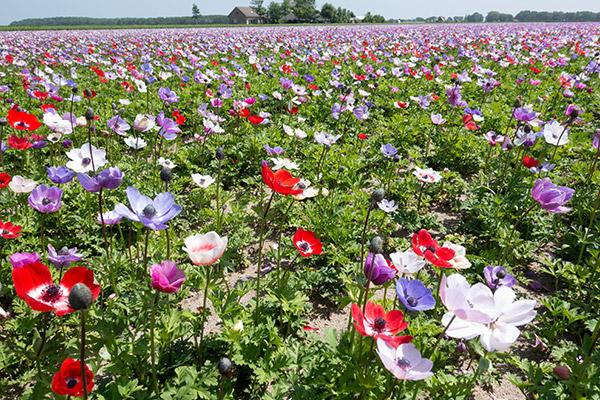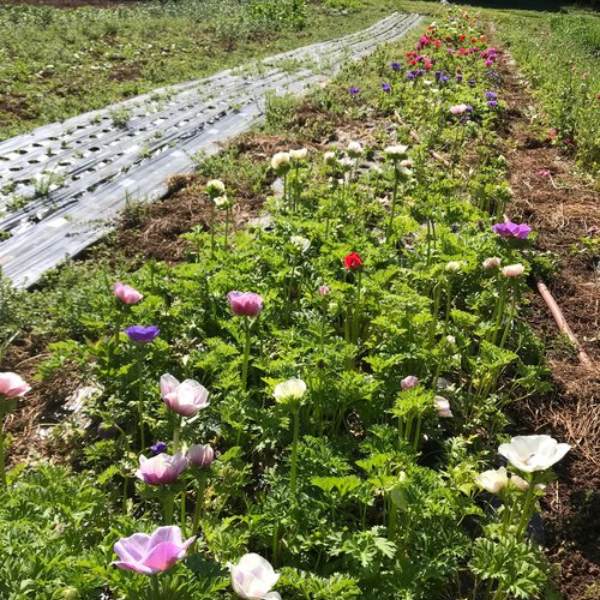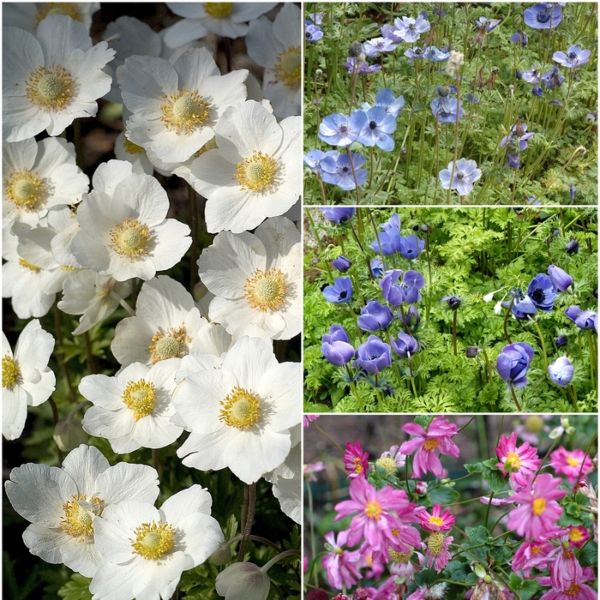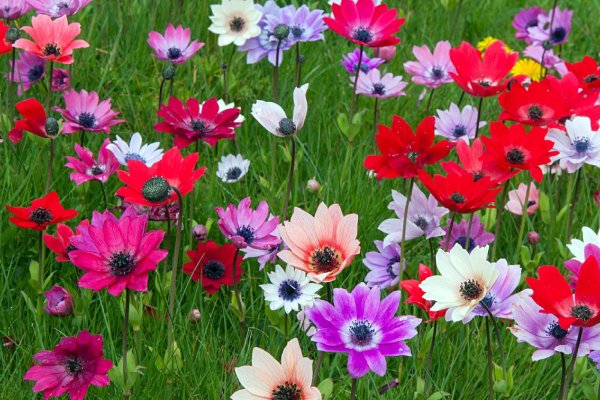Anemone flowers are spring flowers renowned for their vibrant colors and delicate appearance. Their pretty petals and beautiful colors make you feel the magic of spring. Similarly, the beauty of anemones makes popular choices for floral arrangements and gardens, adding elegance and charm to any setting.
In this article, we will explore everything you need to know about Anemone.
Introduction to Anemone Flowers
Anemone flowers, also known as windflower and thimble flower, belong to the Ranunculaceae family. Its botanical name is Anemone spp. It is a perennial type of plants that typically bloom in spring, offering hues ranging from white and pink to vibrant reds and purples. Their charming, cup-shaped flowers feature a prominent ring of colorful petals surrounding a cluster of golden stamens. These delicate flowers are native to North America, Asia, and Europe with over 120 species that thrive in various climates worldwide.
Anemone flowers symbolize love, protection, anticipation, and the cycle of life across cultures. However, in Chinese and Egyptian cultures, anemones were seen as symbols of illness due to their coloring. In some Eastern cultures, including Japanese, they are considered symbols of bad luck or ill tidings. The name “anemone,” derived from the Greek word for “wind,” often represented forsaken love and anticipation of death in art.

Furthermore, anemones are considered toxic to both humans and pets if ingested. So, it is essential to handle this plant with care and keep it out of reach of children and pets to prevent accidental ingestion.
Tips for planting and growing Anemone Flowers
Anemones are easy-to-grow flowers that can be grown in containers or across the ground, adding a lovely touch to any garden or landscape. Here is a simple guide on how to grow these beautiful blooms
When to Plant?
The timing of planting depends on the flowering cycle of your chosen anemone variety. If you are growing bulbs for cut flowers, it’s ideal to plant them in the fall to see blooms in spring. Anemones can also be planted in spring or summer. These easy-care flowers thrive when planted in large groups or patches. In warmer regions, roots develop in autumn, and some foliage may appear, leading to buds and flowers in spring.
In colder areas, it is safer to plant fall-blooming varieties in spring as frost is no longer a risk. While container-grown anemones can be planted at any time during the growing season, spring planting usually gives the best results.
How to Plant Anemone Bulbs?
Growing anemones from seeds can be tough and slow. It is easier to make new plants by taking cuttings or dividing existing ones. If you want to try growing from seeds, collect them from dried flowers. Plant the seeds directly into your garden in the fall, covering them lightly with soil. Anemones aren’t choosy about soil, thriving in well-draining pots or garden beds. Spring-blooming varieties enjoy partial shade, while fall-blooming types prefer partial shade to full sun. Before planting anemones, choose a suitable location based on their preferred light conditions.
How to care for Anemone Flowers?

Light
Generally, Anemones require sunlight daily. Give them four to six hours of bright sunlight daily and partial shade during hot summer months for optimal growth.
Soil
When planting anemones, use soil that is rich in organic matter. Enhance the soil by adding compost or other organic materials before planting. While anemones aren’t too fussy about soil pH, they typically thrive in slightly acidic soil. Ensure the soil drains well and doesn’t become waterlogged during rain.
Water
Anemones prefer regular watering in well-drained soil. In hotter months, water them weekly with a sprinkler or hose. During peak summer with minimal rainfall, water them once a week, focusing on the soil. For the rest of the year, normal rainfall is usually enough.
Temperature And Humidity
Anemones thrive in cooler daytime temperatures. Spring-blooming ones may start to fade as summer heat peaks, while fall-blooming ones may decline as winter nights freeze over. Depending on the type you choose, anemones in colder climates may work better as annual flowers planted each spring.
Fertilizer
Anemones thrive in rich and fertile soil. They typically do well in soil enriched with organic matter and a yearly addition of compost. For robust growth and bigger flowers, fertilize them with a balanced, slow-release fertilizer in both spring and fall.
Choosing the Right Anemone Flowers Varieties
There are around 200 species of vibrant anemones that bloom in spring, summer, and fall. Some grow from corms resembling bulbs, while others have tuberous or rhizomatous roots. Here are some popular types, with flowers that bloom in both spring and fall, to suit different garden tastes.
Rock Anemones
Rock Anemones, also known as Phymanthus crucifer or red-beaded anemones, belong to the Actiniidae family and are often seen in marine aquariums for their bright colors and toughness. They have a unique disk shape, especially when fully open, with edges that don’t curl inward. These anemones stick to rocks or surfaces in the ocean and have tentacles with stinging cells to catch food. They are popular among reef enthusiasts for their beautiful looks and fascinating actions.

White Anemone
White Anemone, also called Anemone sylvestris, is a perennial plant. It produces lots of shiny white flowers that smell nice in spring, and they may bloom again in early fall when it’s cool. These flowers are mostly white but might have a touch of another color at the center or edges. People often grow them in gardens or use them in bouquets because they look classy and timeless. The flowers grow on stems about 18 inches tall and look great in bright woods or sunny wild gardens.
Red Anemone
Red Anemone, also known as Anemone coronaria, is a stunning flower with double blooms resembling daisies. Its cardinal-red petals are eye-catching, complemented by a black center and a delicate white halo. Plant them outdoors in April for summer flowers, or in June for early fall blooms. You can also plant them in pots in a greenhouse or outdoors in autumn if you live in a mild area. They may need some extra care in winter but will reward you with blooms from February to March in early spring.
Blue Anemone
Blue Anemone, or Anemone blanda, blooms from March to April, showcasing single flowers that are 2-4cm wide on short stems above fresh green leaves. They easily spread in favorable conditions. It’s named “blue” due to the typical color of its flowers, which can range from deep blue to purple-blue, though they can also be pink or white. Plant Anemones in partially shady areas with moist soil during autumn, preferably under deciduous trees for ideal sun and moisture balance. They can also grow in full sun if kept moist in fall and spring but dry in summer. The plant dies down by early summer.
Frequently Asked Questions
1. What does the anemone flower symbolize?
Anemone flowers symbolize love, protection, anticipation, and the cycle of life across cultures. However, in Chinese and Egyptian cultures, anemones were seen as symbols of illness due to their coloring.
2. Are anemones bad luck?
In some Eastern cultures, including Japanese, they are considered symbols of bad luck or ill tidings.
3. What are the ideal growing conditions for anemones?
Anemones thrive in well-draining soil rich in organic matter. Spring-blooming varieties prefer partial shade while fall-blooming types can handle partial shade to full sun. Ensure they receive 4-6 hours of direct or bright sunlight daily.
Also read, A Complete Guide to Growing and Nurturing Mexican Hat Flowers (Prairie Coneflower)
